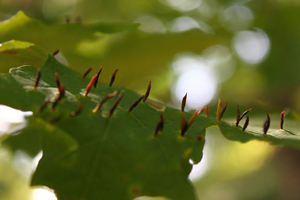Leaf Feeders
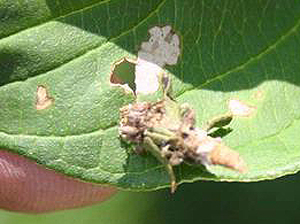
William Fountain, University of Kentucky, Bugwood.org
Bagworms are caterpillars that live in distinctive spindle-shaped silk bags covered with small bits of leaves from the host plant. Large populations of bagworms can strip plants of their foliage and eventually cause them to die. Infestations often go unnoticed because people mistake the protective bags for pine cones or other plant structures. For more information, see Entfact 440.
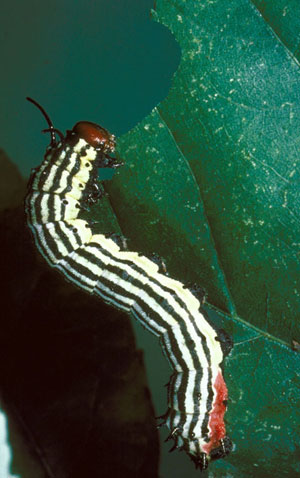
Gerald J. Lenhard, Louisiana State University, Bugwood.org
The Greenstriped mapleworm feeds mainly on maples but can also be found on oaks and boxelders. Larvae can reach up to 1.5 inches and are a light green color, with black stripes and red markings on either end of the body. Two horns are also present near the head. Adults are large and showy, pink and yellow moths that emerge May-July. Eggs laid during this time hatch and young larvae will feed in groups on the undersides of leaves. As they mature, larvae will separate and feed individually. They will leave trees and pupate. A second generation occurs later in the summer with the pupae overwintering.
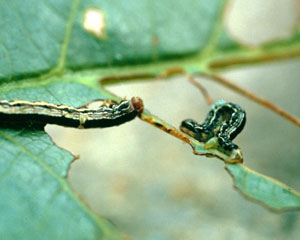
A. Steven Munson, USDA Forest Service, Bugwood.org
Fall cankerworm is a looper caterpillar that can vary from light green with yellow stripes to green with a dark stripe down the back. Overwintering masses of about 100 eggs hatch in later April or early May; small caterpillars chew small holes in young leaves at branch tips. Larger loopers leave only the midrib and major veins. Fall cankerworms are about an inch long when full grown. Mature larvae descend from trees on silk threads to pupate in the soil. They emerge as adults during periods of freezing temperatures to mate and lay eggs on host plants. There is one generation each year.
Sap Feeders
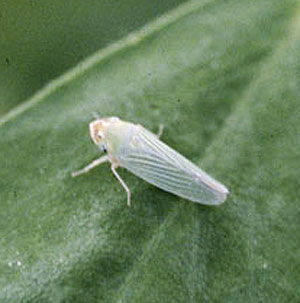
Steve L. Brown, University of Georgia, Bugwood.org
A pest that can also attack agricultural crops, Potato leafhoppers can be pests of maples in nursery production. Other trees susceptible to damage are apple, ash, birch, crabapple, dogwood, oak, elm, hickory, and redbud. The adult is 1/8 inch long, pale green, and wedge-shaped. Nymphs are smaller but look similar to adults otherwise. This pest migrates north in the spring but cannot overwinter in colder states. Individuals feed with piercing-sucking mouthparts that create diagnostic damage called "hopperburn". They inject a toxin with their saliva that deforms leaf tips, curling them and turning them brown.
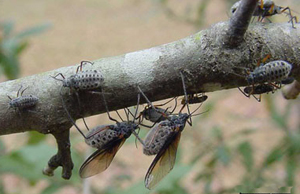
Herbert A. 'Joe' Pase III, Texas A&M Forest Service, Bugwood.org
Giant bark aphid is the largest aphid in North America. This sap feeder can live on several tree species. Winged forms disperse from tree to tree. Wingless aphids occur in large colonies. These aphids produce a large amount of sticky liquid waste, honeydew, which drips onto objects below. Feeding by large numbers of these aphids can damage or kill small twigs. They are eaten by lady beetles and other predators.
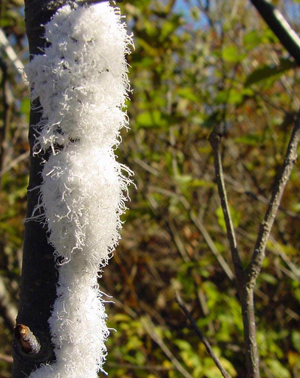
Bob Lepak, Bugwood.org
Woolly alder aphids require both alder and silver maple. Infestations of this insect are easy to recognize because they form white fuzzy colonies on foliage, twigs, or bark. These insects produce large amounts of sweet, sticky liquid waste (honeydew) as they feed. Deposits of this material attract bees, wasps, and flies, and support growth of sooty mold fungus on surfaces where it accumulates. Heavily infested leaves may drop prematurely.
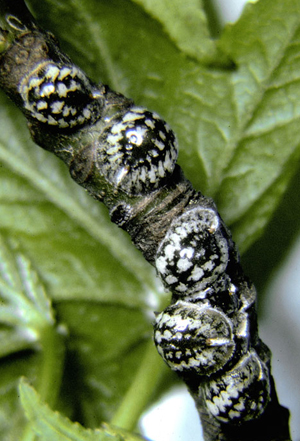
Raymond Gill, California Department of Food and Agriculture, Bugwood.org
Calico scale is a white and dark brown soft scale about 1/4 inch in diameter. It produces a large amount of honeydew in the spring so twigs, branches, and leaves may be covered with sooty mold. This scale can severely weaken trees, making them more vulnerable to drought and other stresses. Egg hatch occurs in May and the crawlers move to leaves to feed for the summer. Nymphs move back to bark for the winter.
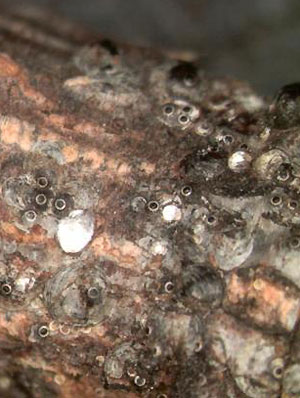
Lorraine Graney, Bartlett Tree Experts, Bugwood.org
Gloomy scale is an armored scale commonly found on red and silver maples. It can be found on many other plants, including sugar maple, boxelder, sweet gum, hackberry, and more. Research at North Carolina State University has shown they are more common in urbanized areas. The waxy covering of gloomy scale blends in with tree bark but does have a pale ring to distinguish it. Symptoms of heavy armored scale infestations are branch dieback and a thin canopy. The immature form of these scales is called a crawler and is the most susceptible stage to control. Gloomy scale crawlers begin emerging in May.
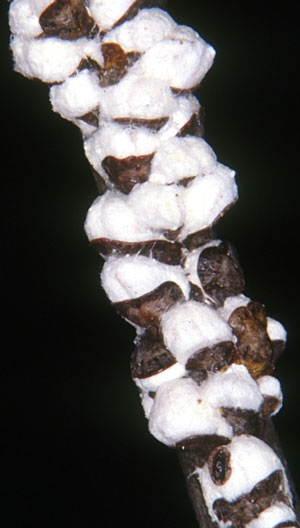
Cottony maple scale is a soft scale that infest maples, boxelder, basswood, birch, elm, and linden trees. This species overwinters as a small immature form and moves to find feeding spots in the spring. By June individuals become mature and egg sacs become noticeable. The eggs hatch in June or July and immature crawlers move to leaves to feed. As autumn approaches, they will move toward bark for winter protection. The adult female scale is 1/8 inch long, brown, and oval. Symptoms of an infestation include dieback, large amounts of honeydew, and black sooty mold.
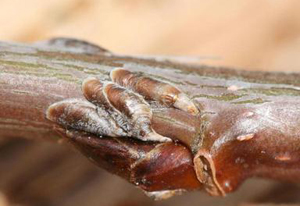
Whitney Cranshaw, Colorado State University, Bugwood.org
Oystershell scales are about 1/10 inch long and resemble crusty accumulations of oyster shells on the bark. Their drab, bark-like appearance makes them easy to overlook, even on close inspection. Heavy infestations can kill twigs or branches. This scale overwinters in the egg stage under the waxy covering of the female. The eggs hatch and the crawlers are active from late May to early June.
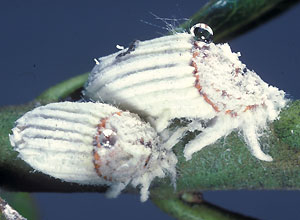
Sturgis McKeever, Georgia Southern University, Bugwood.org
Cottony cushion scale is an invasive scale species that can be found feeding on the sap of numerous species of plants. Adult females are orange-brown but coated with white wax and will have a long, fluted egg sac attached to the body. This can contain up to 1,000 eggs. After hatching, the nymphs (which are red with dark antennae and legs) will seek a suitable space for feeding. Nymphal feeding on leaves can cause extensive damage and honeydew/black sooty mold will accumulate as the population builds.
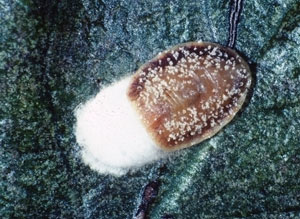
John A. Davidson, Univ. Md, College Pk, Bugwood.org
Cottony camellia scale adult females are about 1/8 inch long but they produce long white egg masses behind them, so they appear much larger. These egg masses are laid on the undersides of leaves and crawlers will hatch and feed throughout the summer. Their feeding results in large quantities of honeydew, which in turn leads to development of black sooty mold.
Borers
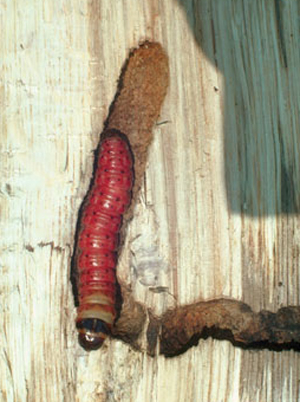
James Solomon, USDA Forest Service, Bugwood.org
Carpenterworms are reddish pink caterpillars that tunnel into the bark and wood of oaks, especially red oaks and a number of other hardwoods. Their damage causes unsightly scars on ornamental trees and degrades rough sawn lumber. Eggs are laid in bark crevices or under vines and lichens. Small larvae feed into the phloem and cambium but soon chew into the sapwood. Fine frass mixed with sap is ejected from the entrance hole in the bark and builds up at the base of the tree as larvae hollow out galleries beneath the bark. Infested trees usually are not killed but long term attacks may weaken trees structurally.
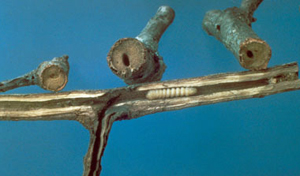
James Solomon, USDA Forest Service, Bugwood.org
Twig pruners are the larvae of small beetles that tunnel in twigs and small branches. Female beetles lay their eggs about the time of bud break in the spring. Eggs are laid in small holes which are chewed into the bark. The larvae that hatch from these eggs bore into and tunnel toward the base of twigs. In late summer, they chew concentric circles outward toward the bark then move toward the tip. The twig eventually snaps and falls to the ground. The larva pupates in the fallen twig and emerges as an adult in the spring. Collecting and destroying fallen twigs can help to reduce infestations.
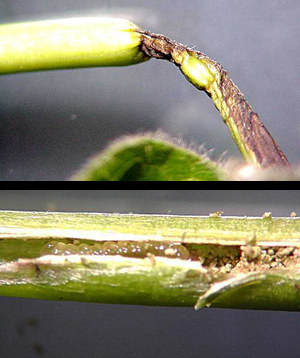
Steve Mayer, Extension Educator-Horticulture
Purdue Extension Marion County
Maple petiole borers are small caterpillar-like insects that tunnel into leaf petioles, weakening them and causing premature leaf drop. They are the larval stages of a sawfly wasp. Leaf loss is seldom enough to affect tree health. For more information, see Entfact 405.
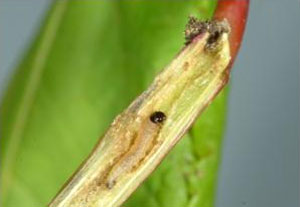
B.L. Seagraves and R. Bessin, University of Kentucky
Maple shoot borer (also known as maple tip moth and maple twig borer) This moth usually attacks red or Freeman maples but can also be found in sugar maples. It can be a serious pest in nursery production, where its tunneling can cause dieback and permanent disfigurement of the plant. The adult moths are active March-May and the female lays eggs on twigs near green-tipped or opening buds. After hatching, the caterpillar will burrow into the shoot and feed until May or June. During this time, you might notice a small hole where frass accumulates. The caterpillar will leave the tunnel and pupate around June. For more information, see Entfact 455.
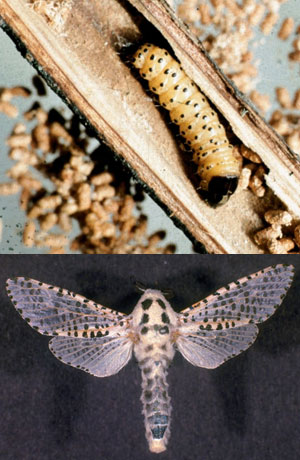
Petr Kapitola, Central Institute for Supervising and Testing in Agriculture,
Bugwood.org (larva);James Solomon, USDA Forest Service, Bugwood.org (adult)
Both the caterpillar and adult of the Wood leopard moth are very distinctive. The caterpillar is the damaging stage, feeding under the bark of host trees. It is a white-orange color with numerous spots on its body. The adult is white with six black dots on the thorax and black markings on the remainder of the body. Adults may be active June-September and larvae feed inside of plants for 2-3 years.
Galls - These galls do not harm tree health.
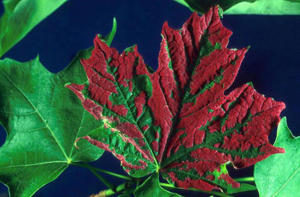
Ronald S. Kelley, Vermont Department of Forests, Parks and Recreation, Bugwood.org
Felt or erineum galls are produced by several species of mites. These appear as light green to yellow-green or crimson velvet-like patches on the underside of leaves.
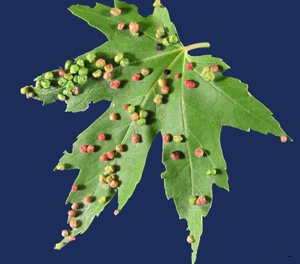
Ronald S. Kelley, Vermont Department of Forests, Parks and Recreation, Bugwood.org
Maple bladder galls occur on silver and red maples. These hollow rounded growths are attached to upper leaf surfaces by narrow stems. Initially, they are green but change color and darken as they mature. Heavily infested leaves may "cup" and drop prematurely. The single mite inside each gall feeds and lays eggs. Activity usually ends in July and the mites pass the winter under bud scales, moving back to leaves as they open in the spring. Outbreaks may occur occasionally but natural enemies generally keep infestations in check.
Maple spindle galls are long, narrow growths on the upper surface of sugar maple leaves. The life cycle is similar to that of the maple bladder gall.
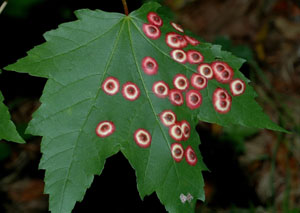
William M. Ciesla, Forest Health Management International, Bugwood.org
The most striking gall on red maple, and occasionally sugar and silver maple, the maple eyespot gall (also called the eyespot midge gall), is caused by a small fly (midge). The small fly lays its eggs in the undersurface of leaves. The maggot that hatches from the egg develops quickly, producing a growth regulating-hormone which causes the development of bright red and yellow rings around the gall, usually in June. The 1/4 inch diameter area later turns brown. The maggot inside the gall completes its development in about 10 days. It then drops to the ground to pupate and transforms into the adult. There is one generation each year.
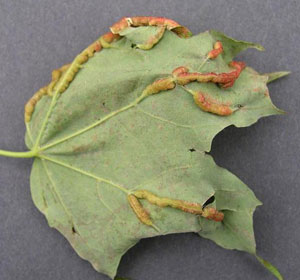
Bruce Watt, University of Maine, Bugwood.org
The gouty vein gall midge is a small fly that causes thickened swellings or purse-like growths on the upper leaf surface along major veins.
